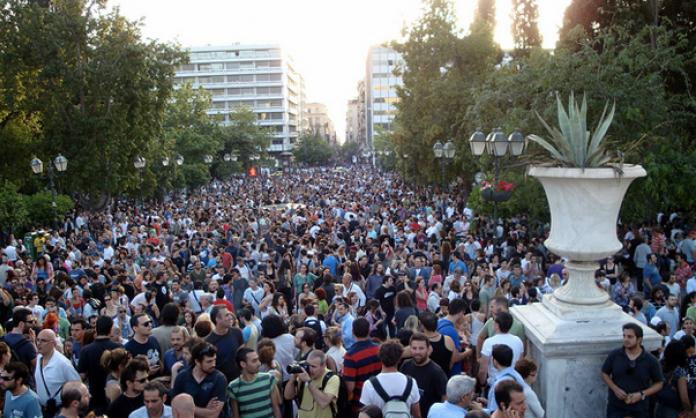“Act now, or we will!” You see this on placards at school students’ protests around the world. How do we carry out this threat? We build a mass movement that can fulfil the demand for “system change to stop climate change”.
The movement needs to set two goals. The first is to strike terror into the hearts of the rich and powerful. Those campaigning for the status quo (like the media and politicians) will reflect that fear in the charges being trotted out against climate activists: they’re all “extremists” wanting “to break down the established civil order and liberal democracy”.
To achieve this first goal, we must achieve another as well: inspire increasing numbers to ever-more radical and determined protest. There is no substitute for mass demonstrations and strikes. But you can’t declare a movement. It has to be built. Young people protesting outside the UN recently chanted, “Don’t just watch us – join us!” Spot on.
The school strikes for climate initiated by Swedish student Greta Thunberg show the effect of people standing together against figures of authority. You only have to witness their marches to see how empowering this experience is. And like all civil disobedience, like all collective expressions of protest, it creates chinks in the repressive armour that protects this system.
By defying school principals, egged on by the likes of Scott Morrison – Australia’s ignoramus supremo – students learn lessons they will never be taught in the capitalist education system. They demonstrate that democracy is enhanced, not undermined, when we defy those who wield authority in this irrational system.
The feeling of strength generated by the act of collectively standing together pushes aside the powerlessness we experience as individuals. This experience lies at the heart of all famous movements against tyranny and oppression, all social action which has won reforms.
Protests change people. They change perceptions of social power.
A public space you have sat in, walked across, never exchanging more than a glance or a smile with others, is transformed by a demonstration. Now the space is ours. Others gather around, considering whether to join in, whether to spill into the streets and march. “Whose streets? Our streets!”
Demonstrations are really a form of a “people’s assembly”: a space where people can debate, discuss, strengthen their collective resolve. Demonstrations cultivate solidarity. Campaigners for the rights of the oppressed gravitate towards others speaking out against other injustices. Just wander around any protest, large or small. You’ll see people signing petitions, gathering around at information stalls about any number of issues, reading leaflets, buying radical papers which both confirm and challenge the ideas we bring with us. As the famous art critic and novelist John Berger put it in an essay in the heady days of 1968:
“A mass demonstration distinguishes itself from other mass crowds because it congregates in public to create its function ... It is an assembly which challenges what is given by the mere fact of its coming together ... By demonstrating, [the protesters] manifest a greater freedom and independence – a greater creativity ... than they can ever achieve individually or collectively when pursuing their regular lives. In their regular pursuits they only modify circumstances; by demonstrating they symbolically oppose their very existence to circumstances.”
The respectable are apoplectic about “civil disobedience”. But most demonstrations, large or small, involve either actual or potential civil disobedience. Strikes are no less civil disobedience than occupations of company headquarters or planned defiance of police in public spaces.
All such actions raise the questions: whose democracy? Whose order? They ask of others: help us disrupt the law and order that entrenches the power of those destroying our world. Disruption can build a feeling of taking some control over circumstances. It says: this movement is one worth taking risks for. It challenges waverers: which side are you on?
In any case, the state faces a dilemma. If police tolerate the manifestations of implied power by demonstrations, the illusion that democracy is open to influence by protests can spur the movement on, becoming an increasing threat to its authority. On the other hand, if cops attack protesters or governments outlaw them, that can spur the movement to new determination and militancy. The authoritarian nature of capitalist democracy is exposed. Even with the most “tolerant” stance, the inevitable police presence represents the state violence that always lurks in the shadows.
Activists learn an important aspect of the art of politics through the experience of responding to the state. When should we defy authority? When should we concede? Assessing the determination and experience of supporters, the intentions of the cops, the level of public support – all are only learnt in the struggle.
Ultimately, workers’ strikes are the most powerful protest. They challenge the right of capitalists to exploit us, to dominate us, to make profits – the very basis of this capitalism. So the inspiration they create is so much higher. They inspire others even more than other kinds of protests, and they open even more possibilities for creative, new ways of organising. Mass demonstrations of striking workers embody power, not just symbolically, but in reality. They show how many people are organising to use their power against our rulers.
Workers have been ground down by four decades of neoliberal attacks. Unions are weakened by defeats and mistaken policies of their leaders. Strike action risks victimisations and fines designed to cripple trade unions. But workers can at times be convinced to leap over what might seem a chasm between themselves and the image of protesters in the media. If there is a movement of radical militancy, one noted for supporting every oppressed group and for opposing attacks on democratic and union rights, then, in the right circumstances, it can inspire workers to take the chance.
There is no template for building a mass movement. Walk-outs, small protests, civil disobedience, mass demonstrations, occupations of public spaces and strikes all make up the arsenal of oppositional movements. The other vital aspect of the art of politics is learning how to link up these different aspects, in ways that build a powerful movement: one that strikes fear into the heart of the exploiting minority, because it illustrates by its size and actions that, in the words of the poet Percy Bysshe Shelley, “We are many, they are few”!











